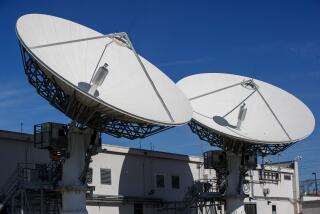NEWS ANALYSIS : Cable Pact Gives Upstarts a Shot at $21-Billion TV Pie : Communications: Operators’ agreement to share programming is a big victory for their rivals, but obstacles loom.
Companies claiming to offer new options to TV viewers, such as satellite broadcasters and microwave transmitters, won a big victory Wednesday when the leading cable operators agreed to share their programming in order to settle a massive federal and state antitrust case.
Now the question is whether those upstarts can capitalize on the victory.
Competitors for the $21-billion cable TV business hope to lure away dissatisfied customers with promises of comparable programming at cheaper prices. But they face considerable obstacles.
Cable now serves 60% of all TV households and touts itself as being on the verge of an interactive, high-tech era in which as many as 500 channels will be offered. Cable operators plan to spend billions of dollars in coming years to upgrade their systems with fiber optics and digital compression technology.
New cable TV regulations passed by Congress last year ordered that cable system operators, many which also own popular program networks such as MTV, CNN and HBO, make those available to competing services. The consent decree between the Department of Justice and the cable companies now makes it nearly impossible for the operators to duck the new rules.
“There’s going to be a rush of new services competing against cable,” promises Peter Price, president of Liberty Cable TV, which offers a 50-channel package of cable channels over microwave frequencies to Manhattan residents for $12 per month. “The cable operators had been doing everything they could to get around the new cable law.”
The cable companies that signed the consent decree, Tele-Communications Inc., Time Warner Inc., Viacom Inc., Comcast Corp., Cox Communications, Continental Cablevision and Newhouse Broadcasting, control more than half the country’s cable households.
They and their allies will be carefully watching the launch of a powerful new satellite this fall capable of beaming signals to consumers with household-mounted dishes about the size of a garbage pail lid. Perhaps one of the most significant threats comes from two well-heeled direct-broadcast satellite services scheduled to begin operation next year.
Los Angeles-based Hughes Communications is spending $600 million to launch DirecTv, a 150-channel satellite service that will offer 50 to 60 pay-per-view movie channels in addition to many of the same networks available on cable. Another service, Minneapolis-based U.S. Satellite Broadcasting, is planning to offer between 20 and 40 satellite channels.
“It’s going to take years for the cable operators to convert to the kind of 500-channel systems many of them are talking about,” says Eddy Hartenstein, president of DirecTv. “So we see a window of opportunity to get a fair number of subscribers” over the next five years.
Hartenstein and other supporters of satellite and microwave broadcasting argue that no one really knows if consumers want--and are willing to pay for--all the interactive entertainment, information and shopping services trumpeted by the cable industry this week during its annual convention in San Francisco. They point out that cable operators haven’t even begun market-testing the new services yet.
But an equally big unknown is whether consumers will spend the $700 it costs to buy the satellite dish and decoder box needed to receive the signals from DirecTv or USSB. On top of that, both services will charge viewers monthly rates based on the number of channels they order.
Microwave broadcasters, however, don’t require any special dishes or decoder equipment--only a willingness among viewers to install a receiving antenna on the roof.
There are already about 100 commercial microwave broadcasters around the country offering up to 33 channels of programming. So far, however, they represent only about 500,000 of the country’s 93 million TV households.
“In cable, success depends on access to the popular branded program services,” says Nick Allard, a Washington lawyer who represented the “wireless cable” operators. “This consent decree greatly strengthens the ability of competitors to go into the cable market.”
More to Read
The biggest entertainment stories
Get our big stories about Hollywood, film, television, music, arts, culture and more right in your inbox as soon as they publish.
You may occasionally receive promotional content from the Los Angeles Times.










